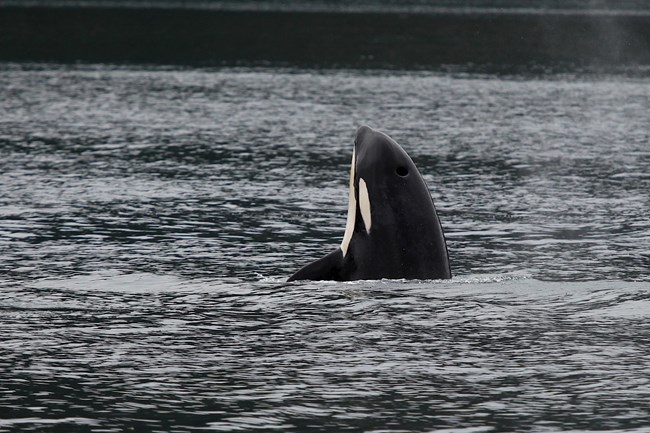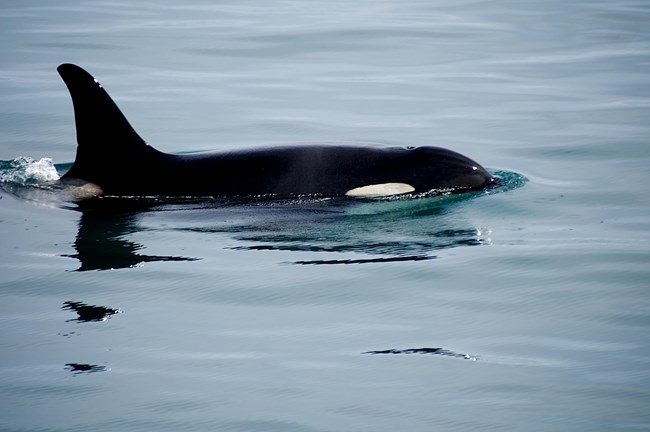
NPS Photo / K. White Orcinus orcaBasic FactsOrcas, or killer whales, are the largest member of the dolphin family, reaching a length of 23 to 26 feet and weighing four to eight tons. Seeing orcas attack large whales, eighteenth century Basque whalers called the predator “ballena assasina” meaning, “whale killer.” Orcas are predatory sea mammals belonging to the suborder Odontoceti or toothed cetacean. Orcas display a prominent dorsal fin easily seen when the animal surfaces. A mature male’s dorsal fin is roughly triangular and can extend up to six feet out of the water. Females and sub-adults have smaller, more crescent-shaped dorsal fins. Orcas have a black body and white chin, belly and patch behind the eye. They also have a gray saddle patch behind the dorsal fin. Researchers use black and white photos of the saddle patch and dorsal fin, viewed from the left side, to identify individual whales. Orcas become sexually mature at 10 to 15 years of age. Upon maturing, the male dorsal fin begins to straighten and grow. The growth spurt distinguishes the male dorsal fin from the female. It takes about five to six years for the fin to reach its full length of up to six feet in height. The life expectancy of killer whales is not yet certain. Using mortality rates among known populations, scientists estimate that these whales live 30 to 50 years. Several females among local resident pods in Alaska have reached over 50 years of age. It is believed some individuals, mostly female, may occasionally reach 80 to 90 years of age. Mature orcas are the top predator, while sharks may also prey upon the young. Except for hunting in the past by humans, most death is thought to be due to age, disease, and environmental toxins such as DDT and PCBs. Examination of carcasses indicates tooth wear and gum disease as well as environmental toxins are problems for the orcas in this area. Habitat, Range and Local SightingsThree kinds of orcas—resident, transient, and offshore—roam the waters around Kenai Fjords National Park. DNA analysis reveals that the three types are genetically distinct populations. Resident and transient populations are most frequently observed. These two types of orcas share the same waters, but their diets differ and they have not been observed associating or interbreeding. Residents eat fish and have a range of at least 800 miles. Transients eat marine mammals and have a range of at least 1,500 miles. Offshore orcas typically live in open ocean areas; during the summer, groups of offshores—or unidentified orcas—turn up in Kenai Fjords. The diet of offshore orcas is not as well known and varies with location and pod (family). Some offshore orcas are known to feed on baleen whales and some pods are believed to possibly feed on sharks. Vocalizations and communicationVocalizations of the two most commonly encountered killer whale forms, resident orcas, and transient orcas, are difficult to distinguish by the untrained ear. Researchers, however, can use these to identify groups as easily as photographs. They help identify not just resident versus transient, but also which pod and even sub-pod the group belongs to. While clicks are primarily used for echolocation, calls and whistles form the basis for social communication. Based on differences in usage of calls, whistles, and clicks, researchers can tell whether the whales are foraging, resting, or socializing. 
NPS photo / Paige Calamari Food and Survival StrategiesResident orcas in the Kenai Fjords and Prince William Sound areas eat silver salmon more than any other fish. The resident orcas also eat halibut and occasionally herring. Transient orcas in this area feed on harbor seals, Dall’s porpoise, harbor porpoise, and sea lions. Transients are stealthier than resident orcas because of the nature of their prey. It is for this reason that viewing transients can be challenging. Transients surface briefly in small groups. They seem to dive and travel beneath the water a long distance. They also employ a technique of traveling close to shore, where rocks may camouflage their dorsal fins. The orca brain is exceptionally large and complex. Particularly well developed, the auditory portion of their brain allows them to transmit and analyze subtle differences in sound. Using echolocation, orcas generate auditory “pictures” so precise that they can pick a silver salmon out of a school of mixed fish. The orca directs its echoes to enhance the acoustic picture; this provides the whale with information about direction, speed, size, shape, and texture of its target. Reproduction and YoungOrca whales share strong social bonds and a complex social structure. Pods are matriarchal societies composed of multigenerational groups. Both male and female orcas tend to remain with their mother’s pod for life. Sub-pods form if the group gets too big. A sub-pod is still associated with the original matriarchal group, but often travels on its own. Females usually bear their first calf between the ages of 12 and 17. Mating generally occurs in late summer and early fall, although it can occur at any time. After a 13- to 16-month gestation period, most calves are born in the winter or early spring. The long gestation period produces well-developed offspring; a newborn has the ability to swim to the surface for its first breath. Calves are seven to nine feet long at birth, weigh about 400 pounds, and may nurse for a year or longer. Orcas are not known to mate within their own pod. Instead, several pods come together and males from one pod will join another pod to mate. This gathering of pods is called a “super pod.” During the mating period, orcas in the super pod breach, spyhop, lob their tails, and display other social behaviors. Locally, there is one day during the summer that a super pod is often observed. From 1992 to 1997 on August 1 in Prince William Sound, researchers recorded a super pod aggregation in Montague Strait; however, in 1998 it seemed as if the pod moved to the Kenai Fjords. Since 1998, super pods have been seen on and around August 1 in the Kenai Fjords. Human ConnectionsNative arts and legends celebrate the orca. Orca whales hunt and fish for the same foods that some Native peoples use. These people revere the whale and respect its abilities as a predator. Historically, cultures less familiar with the orca feared the powerful predators as vicious killers. No documented case exists of a wild orca killing a human. The viewing of orcas in aquariums, on TV, and in the movies has changed public sentiment dramatically. Current attitudes toward orcas and other cetaceans show a new public consciousness about the environment and the protection of wildlife. One group of transient orcas in our area, the “AT1” group, lost 14 of its 22 members after the 1989 Exxon Valdez oil spill. No new calves have been born into this group. As of 2007, the group was down to six individuals. This group of whales is now listed as “depleted” under the Marine Mammal Protection Act. The whales from the AT1 group carry some of the highest levels of industrial contaminants found in any marine mammal. Toxins like DDT and PCBs decrease the effectiveness of the animals’ immune system and could be causing reproductive failure in this group. |
Last updated: March 15, 2018
